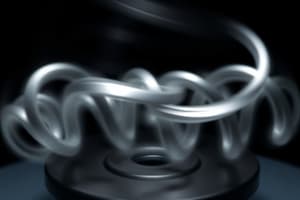Podcast
Questions and Answers
What phenomenon explains why galaxies farther from an observer are moving away faster?
What phenomenon explains why galaxies farther from an observer are moving away faster?
- Cosmic inflation
- Quantum expansion
- Redshift theory
- Hubble's law (correct)
Who were the scientists that discovered the cosmic background radiation that supported the Big Bang theory?
Who were the scientists that discovered the cosmic background radiation that supported the Big Bang theory?
- Albert Einstein and Niels Bohr
- Stephen Hawking and Roger Penrose
- Arno Penzias and Robert Wilson (correct)
- Galileo Galilei and Isaac Newton
What is the significance of cosmic background radiation in the context of the Big Bang theory?
What is the significance of cosmic background radiation in the context of the Big Bang theory?
- It nullifies the existence of dark matter in the universe.
- It represents light from the first stars formed after the Big Bang.
- It is the afterglow from the Big Bang's explosion detected uniformly throughout the universe. (correct)
- It indicates that the universe is contracting rather than expanding.
What do astronomers interpret a larger redshift in the light from distant galaxies to indicate?
What do astronomers interpret a larger redshift in the light from distant galaxies to indicate?
How do Big Bang theorists use the analogy of raisins in cake to explain the expansion of the universe?
How do Big Bang theorists use the analogy of raisins in cake to explain the expansion of the universe?
What main concept differentiates the oscillating universe model from the steady state theory?
What main concept differentiates the oscillating universe model from the steady state theory?
Which aspect of the inflationary universe model addresses problems of the standard big bang model?
Which aspect of the inflationary universe model addresses problems of the standard big bang model?
Who were the key proponents of the steady state theory?
Who were the key proponents of the steady state theory?
According to the oscillating universe theory, what is the ultimate fate of the universe?
According to the oscillating universe theory, what is the ultimate fate of the universe?
What problem does the inflationary universe model specifically aim to resolve?
What problem does the inflationary universe model specifically aim to resolve?
Flashcards are hidden until you start studying
Study Notes
Oscillating Universe
- Albert Einstein favored the oscillating universe model after discarding his initial model.
- Based on general relativity, it features a universe with positive curvature.
- The universe experiences cycles of expansion (Big Bang) and contraction (Big Crunch) due to gravitational forces.
Steady State Theory
- Proposed by Fred Hoyle, Thomas Gold, and Hermann Bondi.
- Predicts an expanding universe that maintains constant density.
- New matter is continuously added to the universe as it expands to prevent density variation.
Inflationary Universe
- Developed by American physicist Alan Guth as an extension to the Big Bang theory.
- Introduces a rapid period of exponential inflation to address the horizon and flatness issues.
- Compares expanding universe to a cake with raisins, where all raisins move apart as the cake expands.
Expansion of the Universe
- Post-Big Bang, the universe has been continuously expanding.
- Galaxies farther away recede faster due to increased space between them.
- This phenomenon results in a redshift of light from distant galaxies, aiding in distance measurement via Hubble's law.
Cosmic Background Radiation
- Discovered by Arno Penzias and Robert Wilson in 1965, revealing faint microwave radiation from all directions.
- Proposed as the afterglow of the Big Bang explosion, detectable throughout the universe.
- Its wavelength and uniformity align with predictions from Big Bang mathematical models.
Formation of Elements
- The initial Big Bang created a fireball that ejected matter and energy at near-light speeds.
- Elements in the universe developed from materials created in the explosion as energy and matter separated.
Hubble's Discovery
- Edwin Hubble's observations in 1929 showed galaxies receding from Earth at speeds up to several thousand miles per second.
- This established the foundational evidence for the expanding universe theory.
Evidence Supporting Big Bang Theory
- Redshift: Demonstrates that galaxies move away due to the Doppler effect; light from receding sources shifts to the red end of the spectrum.
- The relationship between distance and speed provided by Hubble's work supports the ongoing expansion proposed by the Big Bang theory.
Studying That Suits You
Use AI to generate personalized quizzes and flashcards to suit your learning preferences.




